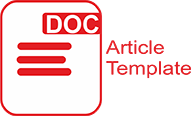Strategi Pengembangan Sagu di Kabupaten Kepualauan Meranti
Abstract
The research objectives were to see (1) determine which sub-districts that have potential for sago development in Meranti Islands Regency, and (2) develop a sago crop development strategy to improve community welfare in Meranti Islands Regency. The research method used in this study is a mix method, which uses a quantitative approach with the Location Quotient (LQ) method to see which sub-districts are based on sago commodities in Meranti Islands Regency. In addition, using a qualitative approach with the SWOT analysis method to see the strengths, weakness, opportunities and threats in the development of sago plants in the region so that alternative strategies for the development of sago in the Meranti Islands Regency are prepared.
The results of the LQ calculation show that the sago plantation commodity is the most superior commodity from other commodities, with an LQ value of 2.7294, meaning that this commodity is a regional superior commodity that can be developed and has great export potential outside the region. The results of the SWOT analysis show that sago development has internal strengths, but is faced with external threats that weaken competitiveness. The results of the space matrix model for sago development in Meranti Islands Regency are in the 5th quadrant For this reason, the sago development model in Meranti Islands Regency is focused on market penetration strategy or through identifying market absorption of the products produced. Market penetration is intended to prevent increasingly fierce business competition from sago products and their derivatives, namely by carrying out an aggressive marketing strategy. In addition, the product development strategy, namely the development of products that have a value proposition and increasing the uniqueness of the product can help the development of sago in Meranti Islands Regency in improving market performance and market expansion.
Keywords
Full Text:
PDFReferences
Bantacut, T. (2014). Indonesian Staple Food Adaptations for Sustainability in Continuosly Changing Climates. Journal of Environment and Earth Science, 4(21), 202-215.
Bukhari, Nurul Adela et al. (2017). Hydrolysis of Residual Starch from Sago Pith Residue and its Fermentation to Bioethanol. Sains Malaysiana, 46 (8), 1269-1278.
Hamidi, Wahyu dan Septina Elida. (2018). Analysis Of Value Added and Development Strategy of Public Sago Agroi ndustry Business in Kepulauan Meranti Regency. International Journal of Scientific & Technology Research, 7(2), 94-99.
Hoque, Md Enamul et al. (2013). Sago Starch-mixed Low-density Polyethylen Biodegradable Polymer: Synthesis and Characterization. Journal of Materials, 2013(365380), 1-8.
Jumiyanti, Kalzum R. (2018). Analisis Location Quotient dalam Penentuan Sektor Basis dan Non Basis di Kabupaten Gorontalo. Gorontalo Development Review, 1(1), 29-43.
Kumar, M., and S. Manivannan. (2015). Biomanagement of Sago Bagasse with Biogas Plant Slurry Using an Indigenous Earthworms Perionyx Ceylanensis Mich. And Lampito Mauritii (Kinberg) for Nutrients Recovery. Pelagia Research Library, 5(12), 12-17.
Makkarennu, O Katsuya dan AR Kadir. (2018). Business Development Strategy of Sago for Food security. IOP Conf. Series: Earth and Environmental Science, 196(012013), 1-8.
Murod et al. (2018). Analisis Struktur Kendala dalam Pengelolaan Sagu Berkelanjutan di Kabupaten Kepulauan Meranti Provinsi Riau. Buletin Palma, 19(2), 101 – 116.
Mulyono, Joko dan Khursatul Munibah. (2016). Pendekatan Location Quotient dan Shift Share Analisis dalam Penentuan Komoditas Unggulan Tanaman Pangan di Kabupaten Bantul. Informatika Pertanian, 25(2), 221-230.
Murod et al.(2019). Strategy of Sago Management Sustainability to Support Food Security in Regency of Meranti Islands, Riau Province, Indonesia. AAB Bioflux, 11(1), 1-20.
Syahza, et al. (2021). Efforts to Prevent Land Fires through the Use of Potential Peatlands in Coastal Areas. Journal of Physics: Conference Series, 2049(012095), 1-8.
Surni et al. (2020). Analysis Of Development Sago Starch Local Food Product Marketing in the Southeast Sulawesi Province. Talent Development & Excellence. 12(1), 1754-1764.
Suyastri, Cipebrima. (2018). Hedging Local Products: Optimizing the Processed Products of Sago Commodity to Become More Competitive Globally Study Case Riau Province. Journal of Diplomacy and International Studies, 1(1), 1-10.
Tiro, B.M.W., P.A. Beding., and Y. Baliadi. (2018). The Utilization of Sago Waste as Cattle Feed. IOP Conf. Series: Earth and Environmental Science, 119 (012038), 1-9.
Trisia, Marlisa Ayu et al. (2016). Promoting Sago Palm in the Context of National Level: Chalenges and Strategies to Adapt to Climate Change in Indonesia. International Journal Sustainable Future for Human Security, 4(2), 54-63.
DOI: http://dx.doi.org/10.31258/jip.18.2.54-62
Refbacks
- There are currently no refbacks.
Copyright (c) 2022 JIP (Jurnal Industri dan Perkotaan)

This work is licensed under a Creative Commons Attribution-ShareAlike 4.0 International License.
















